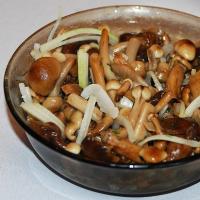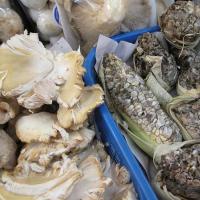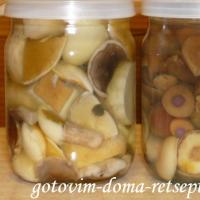§ 14. Hat mushrooms
Among the mushrooms, the most famous are cap mushrooms, these include porcini mushrooms, boletus and aspen mushrooms, multi-colored russula, mushrooms and many others.
In everyday life, we call mushrooms their fruiting bodies. In most edible mushrooms (with the exception of truffles, stitches and morels), the fruiting body is formed by a stem and a cap. Hence their name.
If, in the place where the mushroom is removed (that is, its fruiting body), you slightly tear the soil, you can find thin branching white threads - the mycelium (Fig. 41). The cells of the mycelium of cap mushrooms are often binuclear and do not contain plastids. Mushroom is the main part of every mushroom. Fruiting bodies develop on it. The cap and stem consist of mycelium filaments tightly adjacent to each other. In the stem, all the threads are the same, and in the cap they form two layers - the upper one, covered with a skin colored with different pigments, and the lower one. In some mushrooms, for example, porcini mushroom, boletus, butterdish, the lower layer consists of numerous tubes.
Rice. 41. The structure of the cap mushroom
These are tubular mushrooms. The lower layer of the fruiting bodies of saffron milk mushrooms, russula, volnushka is formed by numerous plates. These are agaric mushrooms.
Spore formation. In the tubes or on the plates of the cap, special cells are formed - spores, with the help of which the fungi reproduce (Fig. 42). Ripened small and light spores spill out, they are picked up and carried by the wind. They are carried by insects and slugs, as well as squirrels and hares that eat mushrooms. The spores are not digested in the digestive organs of these animals and are thrown out along with the droppings.

Rice. 42. Reproduction of a cap mushroom
In moist, humus-rich soil, fungal spores germinate, from which mycelium filaments develop. Mycelium, arising from a single spore, can form new fruiting bodies only in rare cases. In most species of fungi, fruiting bodies develop on myceliums formed by merged cells of filaments originating from different spores. Therefore, the cells of such a mycelium are binuclear. The mushroom picker grows slowly, only having accumulated reserves of nutrients, it forms fruiting bodies.
Mushroom pickers know that boletus can most often be found in a birch forest, porcini mushrooms - near birches, pines, firs and oaks, mushrooms - in pine and spruce forests, boletus - in aspen forests. This is due to the fact that a close relationship is established between certain types of trees and mushrooms, which is useful for both one and the other organism, that is, symbiosis (Fig. 43).
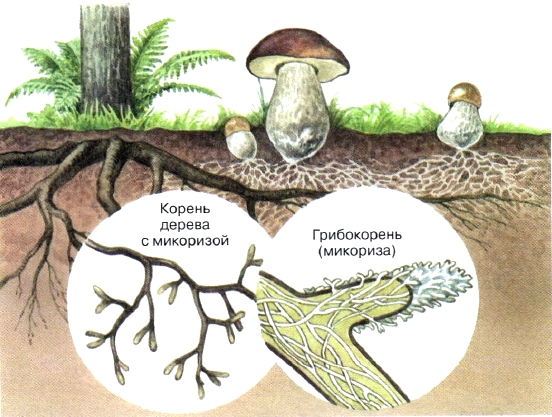
Rice. 43. Symbiosis of fungi and plants
The threads of the mycelium tightly braid the root of the tree and even penetrate into it, forming a fungus root, or mycorrhiza. The mushroom picker absorbs water and dissolved minerals from the soil, which come from it into the roots of trees. In turn, the mycelium receives the organic substances it needs for nutrition and the formation of fruiting bodies from the roots of trees.
Mushrooms are edible and poisonous. Many hat mushrooms are edible (Fig. 44). The most valuable of them are champignons, white, boletus, boletus, boletus, milk mushrooms. The formation of fruiting bodies in fungi of different species occurs at different times. As a rule, morels and stitches appear first in late April - early May, then champignons. In mid-June, when rye is earing, boletus trees appear. Following them - butter, boletus, russula.
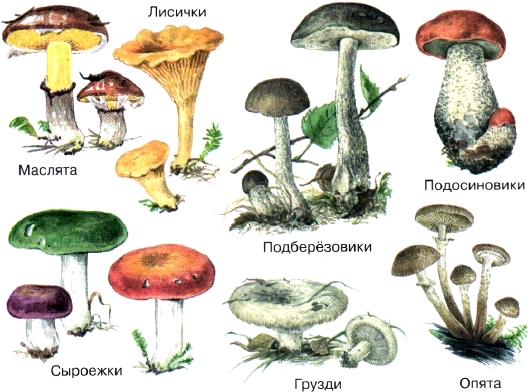
Rice. 44. Edible mushrooms
From the second half of summer until the first frosts, fruiting bodies form mushrooms of all kinds. In dry weather, the fruiting bodies of mushrooms begin to grow only at the end of summer, and when an early cold snap sets in, their growth stops.
When picking mushrooms, it is important to be able to distinguish edible mushrooms from poisonous ones. The most dangerous are the pale grebe, fly agaric, gall fungus, false chanterelles and false mushrooms (Fig. 45). Pale grebes are similar to champignons, only the underside of their cap is greenish-white, in contrast to the pink of champignon.
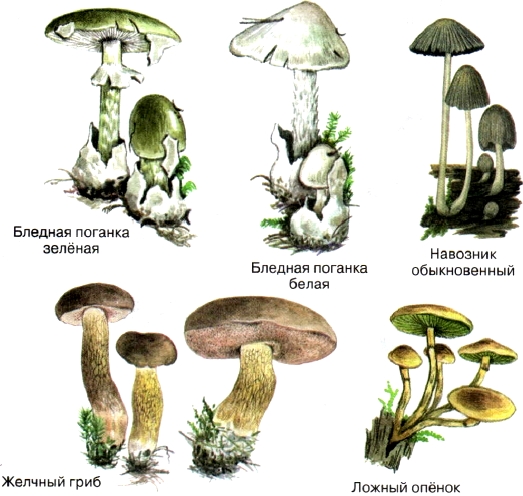
Rice. 45. Poison mushrooms
Fly agaric is easily recognizable by its bright red hat with white spots (Fig. 46). Sometimes there are fly agarics with gray hats.
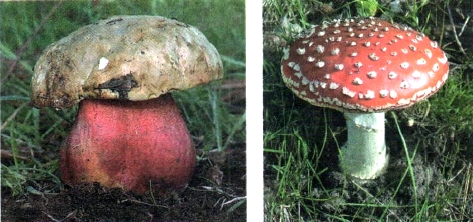
Rice. 46. Satanic mushroom (left) and fly agaric (right)
The gall fungus is similar to white, but the upper part of its hemp is covered with a pattern in the form of a black or dark gray mesh, and the flesh turns red at the break. False chanterelles are similar to edible chanterelles, but their caps are even reddish-orange, not light yellow, as in edible ones, and white juice is released from the broken cap of the false chanterelle.
Edible mushrooms have a ring of film on the stem, while false mushrooms do not have such a film and the plates under the hat are greenish.
In order not to get poisoned by mushrooms, be careful when picking them. If the found mushroom is similar to poisonous or you doubt its edibility, it is better not to take such a mushroom. Old fruiting bodies of edible mushrooms can also be poisonous. You can not pick mushrooms near highways, chemical and other industrial enterprises that pollute the environment with harmful substances. The fruiting bodies of fungi accumulate these substances.
mushroom cultivation. The fruiting bodies of many mushrooms contain nutrients beneficial to humans. Therefore, some cap mushrooms have long been grown under artificial conditions.
Mushrooms are grown in vegetable farms in large cities of our country (Fig. 47). In special workshops, four-tier racks (shelves) are installed. Mycelium is planted on them in nutrient soil. In the premises of the workshops, such a temperature and humidity of air and soil are maintained at which fruiting bodies grow rapidly. More than 20 kg of champignon fruiting bodies are removed from 1 m 2 of soil. Up to five harvests of mushrooms can be obtained per year.
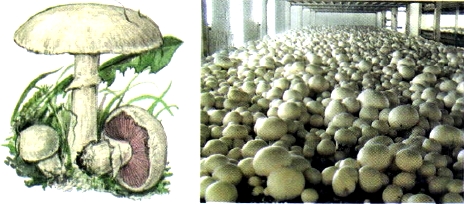
Rice. 47. Growing champignons
Recently, in some farms, the common oyster mushroom has also begun to be bred (Fig. 48).
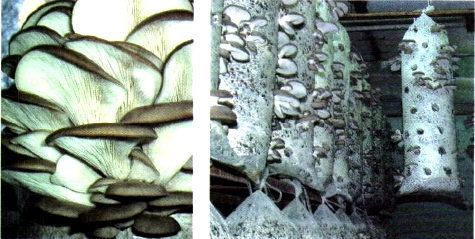
Rice. 48. Oyster mushroom cultivation
New concepts
Hat mushrooms. Mycorrhiza. Symbiosis
Questions
- What mushrooms are called cap mushrooms?
- What is the mycelium and the fruiting body of the fungus?
- How are spores formed in cap mushrooms?
- Why can some mushrooms only live near trees?
- What edible and poisonous mushrooms do you know?
- How are mushrooms grown in artificial conditions?
Think
What is the difference between fungal spores and bacterial spores?
The structure of the fruiting bodies of cap mushrooms
- Consider the fruit bodies of cap mushrooms. Find their main parts.
- Consider the structural features of the underside of the cap. Based on their structure, divide mushrooms into lamellar and tubular.
Quests for the curious
In the summer, collect mushrooms, put caps of agaric and tubular mushrooms on dark paper (underside). After a day, carefully remove the hats from the paper, you will see a peculiar pattern on it, which is formed by spilled spores.
Do you know that...
- The fruiting bodies of puffball mushrooms can reach enormous sizes. Raincoat mushrooms were found with a diameter of up to 2 m.
- When harvesting, do not dig mushrooms out of the soil, as in this case the mycelium is damaged. Fruiting bodies should be twisted out of the soil with light, careful movements. In this case, the threads of the mycelium are almost not damaged.

